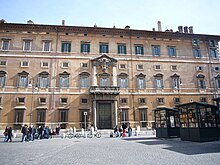Borghese Palace
The Palazzo Borghese , also called "il Cembalo Borghese" after its external appearance similar to a keyboard instrument , is the urban apartment of the Roman Princely House of Borghese . It is one of the most magnificent buildings in Rome .
Cardinal Camillo Borghese acquired the palace , which was built in 1560 and later converted by Martino Longhi in 1604, shortly before he took office as Pope Paul V. After he was elected Pope in 1605, he left the building to his brothers Francesco and Giovanni Battista. The new owners entrusted Flaminio Ponzio with the task of expanding it into a residence suitable for the papal family. Until 1613 he created the wing on the Piazza Borghese and also the inner courtyard, which is enclosed on three sides by two-story arcades. The grand piano on Via di Ripetta, "the keyboard of the harpsichord ", was also created during this period. After Ponzio died, Carlo Maderno took over the completion of the palazzo until 1614. In the second half of the 17th century, Carlo Rainaldi carried out work on the interior of the wing on Via di Ripetta and the gardens.
The west wing of the palace extends to the right bank of the Tiber and is located approx. 500 m northeast of Piazza Navona and approx. 500 m west of the Spanish Steps . The external impression is monumental and representative: three floors and two mezzanines as well as two majestic entrances flanked by columns with balconies above. The main entrance leads into the aforementioned arcade courtyard , in which there are several famous ancient sculptures from the Borghese collection. An open double loggia at the back leads from the inner courtyard to an idyllic garden courtyard that houses three richly decorated fountains.
The first major part of the interior decoration of the palace was carried out from 1614 by Paolo Piazza and Giovanni Francesco Guerrieri and completed in 1618 for the wedding of Marcantonio Borghese , the Pope's nephew , and Camilla Orsini . A large number of artists were involved in the further decoration of the interiors in the 17th and 18th centuries.
The palazzo was one of the centers of aristocratic Rome. For 200 years it housed the famous collection of paintings by Cardinal Scipione Borghese , which the Borghese family has gradually expanded. It filled twelve large halls on the ground floor, among the pictures were the burial of Raphael , the hunt of Diana and the Cumaean Sibyl by Domenichino , Arpino's Rape of Europa , Madonnas by Francesco Francia , Lorenzo di Credi , Andrea del Sarto , Lorenzo Lotto , Giulio Romano , Correggios Danae, Titian's education of Cupid through Venus and the Graces as well as his heavenly and earthly love, van Dyck's Christ on the cross and the burial. In 1891 the painting collection was moved to the Villa Borghese , which the Italian state then bought together with the complete interior decoration between 1900 and 1902.
The palazzo is still inhabited by various members of the family, including the head of the family, Prince Scipione Borghese, Principe di Sulmona e Rossano (* 1970) and his wife Donna Barbara Massimo dei Principi di Arsoli.
See also
literature
- Heinz-Joachim Fischer : Rome. Two and a half millennia of history, art and culture of the Eternal City. DuMont Buchverlag, Cologne 2001, ISBN 3-7701-5607-2 , pp. 237-238.
- Anton Henze: Art Guide Rome. Philipp Reclam, Stuttgart 1994, ISBN 3-15-010402-5 , p. 286.
- Rome. vis-à-vis travel guide. Dorling Kindersley Verlag, Munich 2008/2009, ISBN 978-3-928044-41-7 , p. 112.
- Christoph Höcker: Reclam's city guide - Rome. Philipp Reclam jun., Cologne 2008, ISBN 978-3-15-018512-4 , p. 121.
Web links
Coordinates: 41 ° 54 ′ 14 " N , 12 ° 28 ′ 35.4" E





